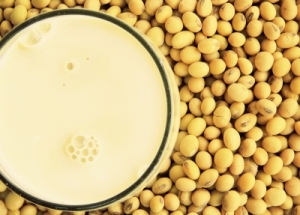Menopause is a time of change, a time to really focus on our health and wellbeing and giving our bodies the best we can, and with scares and concerns over HRT, we are all trying to follow a more alternative path.
We are constantly bombarded with what is good and what is bad for us. The buzz words, super foods and trendy diets.
Native to East Asia this little bean, the soy bean, made a big entrance and we were told to drink it, eat it and take it in supplement form. Then studies were made and we were told the sometimes confusing information of the damaging effects and links with breast cancer. So is soy a fad? Is it cheap to make? Is it just business and why is it promoted as a health food?
‘Somehow, the ancient Chinese knew that soybeans still contain many toxins after cooking and thus avoiding eating it until they learned to neutralise those toxins through fermentation. In traditional Asian diets, soy is only used in small amounts as a condiment, with pork, seafood and other animals providing the bulk of the protein. Only very recently has soy been eaten the way we typically eat it, consuming large amounts in an unfermented and often highly processed form’
http://www.optimumchoices.com/Soy.htm

The Good
Soy is derived from the soya bean, a cholesterol free, high in protein legume that has been known to have many health benefits, controversially including the fight against breast and prostate cancer, menopausal symptoms, heart disease and osteoporosis. This little bean contains large amounts of polyunsaturated fat, fibre, vitamins and minerals, such as B vitamins and omega-3. It may help decrease unnecessary carbohydrates from empty calories. Soy at its best is found in tofu, tempeh and miso the traditional Asian soy product, rather than the synthetic or processed form. According to the Linus Pauling institute “diets rich in soy appear safe and potentially beneficial”. From that, maybe keep to the recommended daily amount (25 grams per day) or if concerned opt for alternative foods.
…….and the Bad
The researched risks of soy have actually been studies on the isoflavones, which seem to be causing the issue. These powerful phytoestrogen chemicals found in soy plants have been found to work like oestrogen in the human body and are most prevalent in soy foods than in any other foods. This could potentially be a risk to women during menopause as studies showed soy phytoestrogens have the oestrogenic effect of stimulating growth of breast cancer cells in tissue cultures. These studies revealed that soy protein isolates stimulate growth of normal breast cells much the way that natural oestrogens do. Being that progesterone is low and decreasing during menopause this could add to breast cancer risk.

The Conclusion
If high levels of soy’s phytoestrogens (isoflavones) found in predominately synthetic supplements, protein powders and processed foods are consumed, research shows that it may disrupt the endocrine system and could lead to a higher risk of breast cancer and other hormonal and vitamin imbalances. The findings have not established the efficacy and safety of soy isoflavones. The main concern is the fact that the chemical composition of isoflavones is similar
The old saying is ‘everything in moderation’ and if you’re consuming a healthy diet without eating or drinking large quantities of soy, then you lower your risk of an imbalance in mentioned health issues or disruption of hormone levels. Life is about balance, especially during menopause.
Alternatives
Coconut and almond milk are great if you have been drinking soymilk and want something different to avoid too much consumption
To still have that all important balance of protein on a daily basis, other foods are turkey, fish such as tuna, salmon and halibut, cottage cheese, pork loin, lean beef, eggs, natural yoghurt, nuts and seeds.
‘The richest sources of phytoestrogens in the human diet include soybeans, red clover, whole grains and flaxseed. Herbs with high concentrations of phytoestrogens include hops, thyme, liquorice and verbena, notes NYU Langone Medical Center. Some herbs often thought to have phytoestrogens that in fact do not include saw palmetto, wild yam, chasteberry, ginseng, black cohosh and dong quai. These herbs may, however, mimic the effects of estrogen in certain conditions’
http://www.livestrong.com/article/83849-foods-contain-phytoestrogen/
Reference – http://www.johnleemd.com/store/soy_menopause.html
Reference – http://www.optimumchoices.com/Soy.htm
Reference – http://www.livestrong.com/article/85804-foods-rich-isoflavones/
